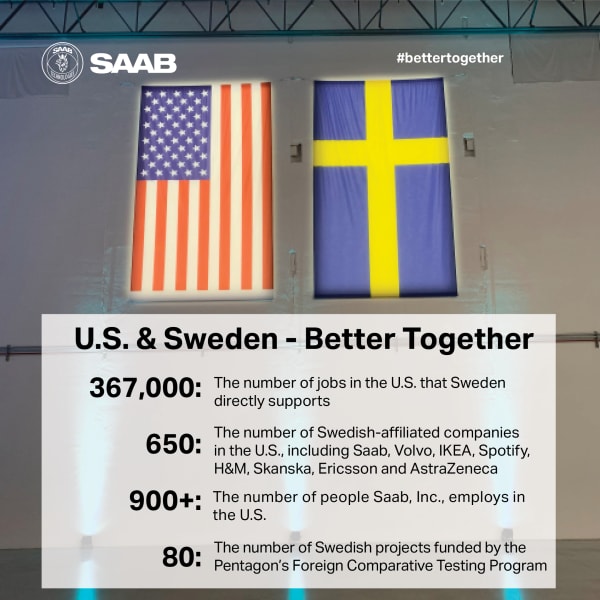Sweden and the United States: A Legacy of Democratic Cooperation
For hundreds of years, Sweden and the U.S. have flourished as like-minded democracies with ongoing partnerships. Learn how the long-standing cooperation between Sweden and the United States has led to innovative technological developments and other lasting benefits, from job creation to shared research initiatives.
Sweden and the United States have a shared heritage dating back to 1638, when the first Swedish immigrants arrived on the shores of Delaware. In 1783, Sweden was one of the first countries to recognize U.S. independence. For hundreds of years, Sweden and the U.S. have flourished as like-minded democracies with ongoing partnerships.

Together, the two nations have achieved innovative technological developments across industries to benefit both nations’ citizens. A reflection of this long-standing partnership, Saab, Inc. is proud to be a U.S. subsidiary of a Swedish company serving civil and military needs in the United States.
Jobs Creation & Direct Investment
- The U.S. is the largest destination for Swedish foreign direct investment.
- In 2019, Sweden invested more than $61 billion in the U.S.
- This places Sweden as the 13th largest investor in the U.S., ahead of China, Mexico and South Korea.
- There are more than 650 Swedish-affiliated companies in the U.S., with locations in all 50 states, Washington, DC and Puerto Rico. These companies include prominent industry leaders like Saab, Volvo, IKEA, Spotify, H&M, Skanska, Ericsson, and AstraZeneca.
- Sweden directly supports more than 367,000 jobs in the U.S.
- 310,000 jobs created by Swedish-affiliated companies in the U.S.
- 37,000 jobs supported by the export of services from the U.S. to Sweden.
- 20,000 jobs supported by the export of goods from the U.S. to Sweden.
- These businesses also indirectly support almost one million jobs via suppliers, supporting employment and affiliated subcontractors.
- Saab employs more than 800 people in the U.S., nearly 15% of whom are veterans of the U.S. armed forces. Our facilities are in California, Florida, Indiana, Massachusetts, New York, Rhode Island, Virginia, and Washington, DC.
Keeping People and Society Safe
- U.S. Department of Defense’s Foreign Comparative Testing program has funded more than 80 projects from Swedish companies, more than 30 of which resulted in procurement acquisitions totaling $1.5 billion to expand U.S. military capabilities.
- Today, Saab, Inc. has programs of record with all branches of the U.S. armed forces and established partnerships with all major U.S. Defense Industry contractors.
- Saab, Inc. provides air traffic management solutions to the Federal Aviation Administration to protect commercial aircraft and civilians, including surface movement radars, vehicle trackers, and airport command and control systems.
- Saab, Inc. has also supplied U.S. armed forces with radars and sensors, ground combat support systems such as the AT4 and Carl-Gustaf shoulder-launched weapons for the U.S. Army, Marine Corps and others, as well as a state-of-the-art trainer jet in the T-7A.
- Sweden and the U.S. share a commitment to aiding Ukraine. Sweden has committed nearly $2 billion in military and economic aid to Ukraine thus far and has opened its borders to 50,000 Ukrainian refugees.
Shared Research Initiatives
- In 2023, Saab, Ericsson and Purdue University started a new research project in Indiana to develop commercial 5G solutions to improve operations and security at airports of all sizes.
- In 2022, the U.S. and Sweden began a research cooperation to explore the future applications of quantum information science and technology (QIST), such as quantum computing.
- In 2022, the U.S. and Sweden launched the Green Transition Initiative (GTI) to support green technology implementation in the United States in sectors such as transportation, energy, industry and sustainable buildings.